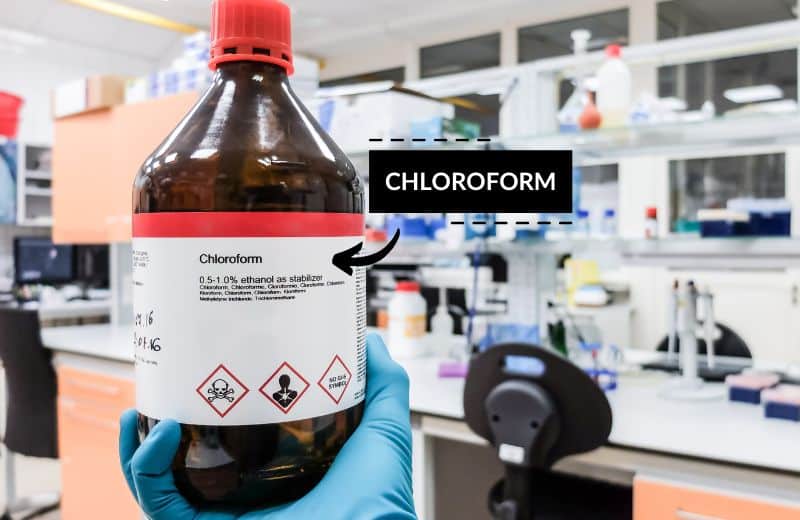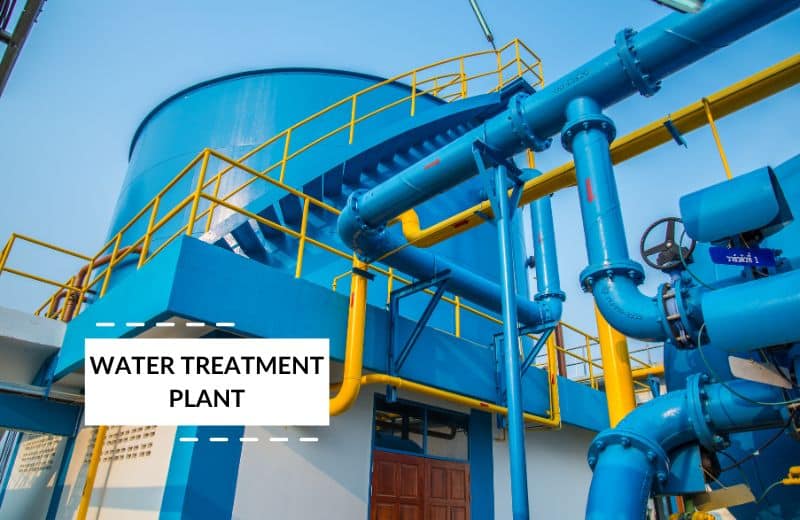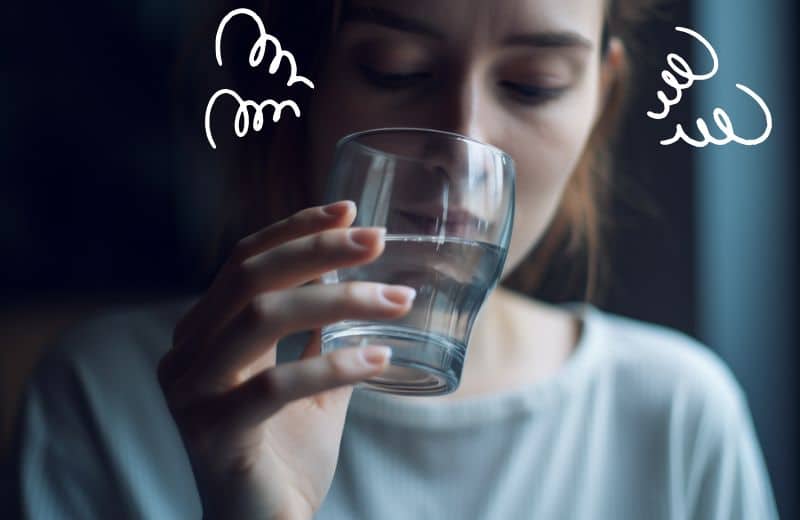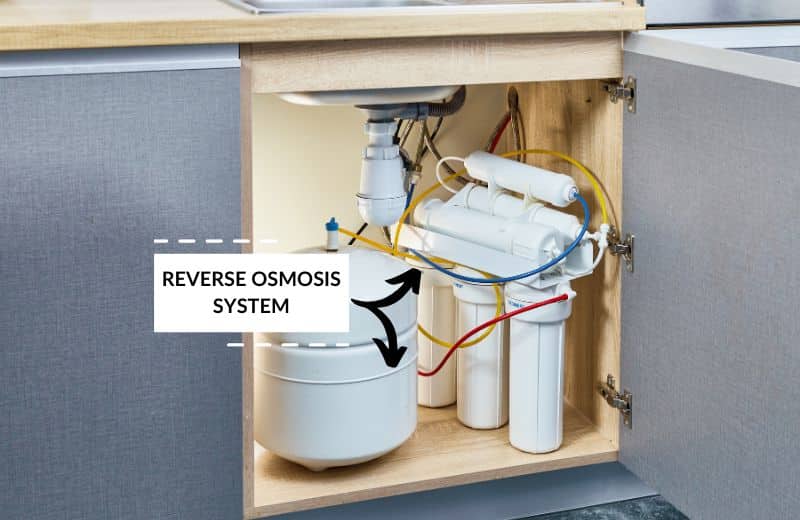If you receive a disinfected municipal water supply, there’s a good chance that your water contains chloroform. This disinfection byproduct is commonly found in drinking water that has been treated with chlorine, and while research is lacking, we know that it has several dangerous health effects.
Here, we’ve shared everything you should know about how to remove chloroform from water with the best at-home water treatment methods.
📌 Key Takeaways:
- Chloroform is a disinfection byproduct in the trihalomethanes group, and is commonly found in chlorinated water.
- Some of the possible health effects of long-term chloroform exposure are cancer, liver and kidney damage, and reproductive issues.
- You can remove chloroform from your water with a reverse osmosis system, a GAC filter, or a water distiller. You can also boil your water for at least one minute.
Table of Contents
💡 What Is Chloroform?
Chloroform is a disinfection byproduct byproduct (DBP) that can be produced when chlorine is used to disinfect water. Chlorine is a common disinfection chemical used in water treatment plants because of its affordability and effectiveness when used in large-scale applications. However, it’s linked to the formation of several disinfection byproducts, including chloroform.
The formation of chloroform occurs when chlorine reacts with the organic matter (such as compounds from humic substances and decaying plant matter) naturally present in the water supply.
Chloroform is one of the trihalomethanes (THMs) that commonly contaminate chlorinated drinking water supplies. THMs are of concern because some studies have suggested that they have several potential health risks in people exposed to these chemicals in the long term.

❓ Is Chloroform in Water Harmful?
Yes, chloroform and other trihalomethanes in water can be potentially harmful, especially if they’re present at elevated levels, and especially if you’re exposed to these disinfection byproducts over an extended period of time.
There are several possible health effects of chloroform, as highlighted in a number of studies. We’ve discussed the possible effects of chloroform contamination in water later.
The risk level of chloroform in water depends on the concentration of chloroform and other disinfection byproducts present, as well as how frequently you’re exposed to the chemicals. Water treatment plants and regulatory authorities are aware of the dangers of chloroform, and your local water treatment plant should be working to minimize chloroform levels in your treated water.
🤔 How Does Chloroform Get Into Drinking Water?
Chloroform enters a tap water supply as a result of disinfection with chlorine.
Let’s look at the three-stage process of chloroform contamination in chlorinated tap water.
Stage 1: Disinfection
The problem starts when water is disinfected at the treatment plant. Chlorine is the most common drinking water disinfectant because it’s affordable and widely available.
Chlorine plays an important role in disinfection, and our tap water wouldn’t be safe to drink without this treatment. However, that doesn’t discount the negative side-effects of using chlorine or other chemical disinfectants, namely the formation of disinfection byproducts like chloroform.

Stage 2: Reaction With Organic Matter
Once water has been disinfected with chlorine, residual chlorine lingers in the water as it travels to your home, helping to protect the water from viruses, protozoan cysts, and bacterial contamination.
During disinfection and the water’s journey to your home, the chlorine reacts with naturally occurring organic matter in the water. The rate and number of reactions that take place depend on factors including the quantity of chlorine used for disinfection and the concentration of organic compounds present in the water.
Stage 3: Formation Of Chloroform
The reaction between chlorine and organic matter results in the formation of disinfection byproducts, including chloroform. These byproducts are a consequence of the chlorine reacting with organic matter.
Chloroform is a THM – a specific class of disinfection byproducts that also includes bromoform, bromodichloromethane, and dibromochloromethane.
This chemical lingers in your water supply and is found in the water that comes out of your tap.
📑 Possible Health Effects of Chloroform
There are several possible health effects of chloroform, as outlined by the Environmental Protection Agency (EPA).
These include:
- Cancer – Chloroform is possibly carcinogenic, with some studies finding an association between exposure to disinfection byproducts in chlorinated water (including chloroform) and cancer of the large intestine, rectum, and/or bladder.
- Reproductive and developmental effects – Prolonged exposure to high levels of chloroform and THMs has been associated with adverse reproductive outcomes, including developmental issues in fetuses and miscarriages.
- Kidney and liver problems – Studies indicate that exposure to high levels of chloroform and THMs in drinking water might be linked to liver and kidney damage, including an increased risk of liver and kidney tumors.
- Nervous system effects – There is some evidence suggesting that prolonged exposure to chloroform and THMs may be linked to central nervous system depression.
It’s important to note that there are very few studies that specifically look at the possible health effects of chloroform, or even those that focus specifically on THMs or disinfection byproducts as a whole.
Much of this evidence is based on emerging studies, and it’s likely that our awareness of the dangers of disinfection byproducts will continue to grow as more research is carried out.

✅ How to Remove Chloroform from Tap Water
Below, we’ve outlined the best methods to remove chloroform from your drinking water.
1) Boiling
If you don’t want to spend any money on a dedicated water system for removing chloroform, simply boiling water at home is an effective way to reduce this disinfection byproduct.
Make sure to bring your water to a rolling boil for at least one minute, which should (according to a scientific review from 2004) be effective in reducing the chloroform concentration by 75%.
So, while boiling your water won’t eliminate chloroform, it will reduce this byproduct significantly, so it’s certainly better than nothing.
2) Granular Activated Carbon Filtration
Filtration with a granular activated carbon (GAC) filter is an effective way to remove chloroform from your drinking water.
You can find a variety of filters that use GAC media, including under-sink systems, whole-home filters, and water pitcher filters.
According to a report by the University College London, GAC used as a post-disinfection treatment was able to reduce 76.4% of chloroform in drinking water. This method of treatment can also reduce other disinfection byproducts, including bromate, bromoform, bromodichloromethane, and dibromochloromethane.
A big benefit of GAC filters is that they’re cheap. You can buy a single-filter under-sink water filter system that uses GAC media to effectively reduce chloroform for less than $100 upfront and a similar annual spend.
3) Reverse Osmosis Purification
Reverse osmosis purification is another highly effective method of reducing chloroform in tap water.
A reverse osmosis filter combines several stages of filtration, including sediment and carbon filters, with a semi-permeable membrane. This membrane is capable of reducing up to 99% of all total dissolved solids in the water, including disinfection byproducts like chloroform.
A 2009 study published in the Iranian Journal of Environmental Health Science and Engineering reported that reverse osmosis purification could remove up to 80% of the THMs, including chloroform. We’ve reviewed reverse osmosis systems that have been tested and certified to remove higher concentrations than this – more than 99%.
You can buy a reverse osmosis system to install underneath your kitchen sink or on your kitchen countertop. There are also whole-home RO systems available, but these are very expensive.

4) Water Distillation Systems
We also recommend using a water distillation system to greatly reduce chloroform in your drinking water.
A water distiller has a boiling chamber, where water is added. This water is heated until it evaporates, leaving its impurities – including chloroform and other disinfection byproducts – behind.
The evaporated water travels into a separate container, where it condenses in its pure form. A water distiller can remove up to 99.5 percent of all impurities from water, including chloroform.
Water distillers are relatively cheap and have the advantage of being virtually cost-free to run, with no filter replacements required. However, these systems are incredibly slow to produce a batch of purified water, so they aren’t an on-demand water purification solution.
❔ Frequently Asked Questions
Can chloroform be filtered out of water?
Yes, chloroform can be filtered out of water. The best filtration methods to reduce or remove chloroform are granular activated carbon and reverse osmosis, which remove more than 75% of chloroform from water.
Does chloroform go away?
Yes, chloroform eventually breaks down in water. However, the breakdown process is very slow, so it’s unlikely that the chloroform levels in your water will drop at all, even if you store it for several days before drinking.
Can you boil chloroform out of water?
Yes, you can boil chloroform out of your water. Make sure to boil your water for at least one minute, which will remove around 75% of chloroform. Boiling your water for less than one minute will only reduce around 30% of chloroform.
Can you shower in water with chloroform?
Yes, it’s usually safe to bathe and shower in water that contains low levels of chloroform and other disinfection byproducts. However, research suggests that inhaling chloroform from water vapor in the air while you’re showering is another source of chloroform exposure. You may prefer to remove chloroform from your entire home’s water supply with a POE water filter to eliminate all possible sources of chloroform exposure.
How can water treatment plants prevent the formation of chloroform?
There are a few different ways that water treatment plants can prevent or at least reduce the formation of disinfection byproducts like chloroform. The first would be to use a non-chemical form of disinfection, like UV purification. However, the problem with this method is that it doesn’t provide continuous disinfection and it’s expensive to employ. A more affordable alternative is to use a disinfection pre-treatment to reduce the amount of organic compounds in water, therefore reducing the reactions between chlorine and these compounds and limiting disinfection byproduct production.
